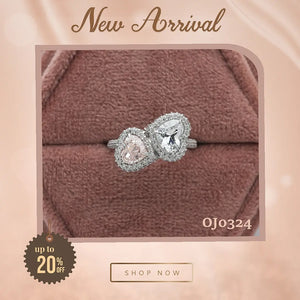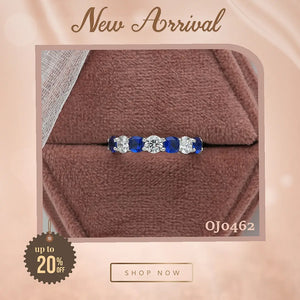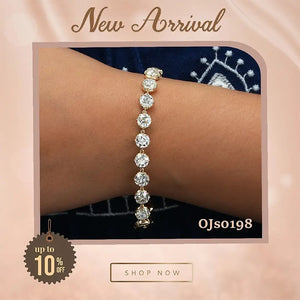Simulant Diamonds vs. Lab-Created Diamonds: Understanding the Difference
![[Simulant Diamonds vs. Lab-Created Diamonds: Understanding the Difference]-[ouros jewels]](https://cdn.shopify.com/s/files/1/0527/7669/8040/files/imulant_Diamonds_vs_Lab_Created_Diamonds_1024X512_5f6d3700-e45e-402a-94a7-444a18c41736_1024x1024.webp?v=1715163559)
What Are Lab Grown Diamonds?
Lab-grown diamonds are similar to natural diamonds in look, sparkle, and hardness because they are both made from carbon. The main difference is in their creation: Lab-grown diamonds are created in a controlled laboratory environment, similar to manufacturing ice cubes in your freezer, while natural diamonds form naturally over millions of years deep under the Earth and get to the surface via volcanic activity.
![[What Are Lab Grown Diamonds?]-[ouros jewels]](https://cdn.shopify.com/s/files/1/0527/7669/8040/files/Lab_Grown_Diamonds_480x480.webp?v=1715158952)
To the naked eye, these types of diamonds look the same, and it usually takes advanced technology and experts to detect the difference. This makes lab-grown diamonds an eco-friendly and affordable option for many people, mostly those looking for ethical and ecological jewelry.
What Are Simulated Diamonds?
Diamond simulants are synthetic gemstones that like diamonds, but both look different in look and composition. Simulated diamonds include cubic zirconia (CZ) and moissanite. While these stones look like real diamonds, they are not natural diamonds and do not have the same chemical or physical attributes.
![[What Are Simulated Diamonds?]-[ouros jewels]](https://cdn.shopify.com/s/files/1/0527/7669/8040/files/Diamond_Simulants_480x480.webp?v=1715158985)
These stones are much more less expensive than both lab-grown and natural diamonds. Simulated diamonds are known for their sparkling and vivid brilliance, which is often more vibrant than that of natural diamonds. This different sparkle makes it simple to tell the difference between simulated and real diamonds with the naked eye, making them a popular choice for budget-conscious jewelry buyers.
What’s The Difference Between Simulated And Lab Created Diamonds?
Lab-grown diamonds have the same physical, chemical, and visual qualities as naturally mined diamonds, making them real diamonds. They look just like natural diamonds, and without advanced tools, it's hard to spot any differences. These diamonds are created under conditions similar to how natural diamonds develop, giving them the same beauty and durability. These diamonds are as hard and durable as natural diamonds, with a Mohs Hardness rating of 10.
Diamond simulants, like moissanite and cubic zirconia (CZ), are more visible because they sparkle and reflect more colors. While they look similar, they don't have the same sparkel and are a bit softer. Moissanite has a hardness of 9.25, but CZ has a hardness of 8.5, making them more durable but more likely to scratches over time.
When it comes to pricing, lab-created diamonds are around 50-70% less expensive than real diamonds, providing a more affordable option without losing beauty. They are priced according to size, shape, cut, color, and clarity. Simulants such as moissanite diamonds are even more affordable, with pricing mostly determined by size and whether they are rated Premium or Super Premium quality.
Lab Grown Diamonds
![[What’s The Difference Between Simulated And Lab Created Diamonds?]-[ouros jewels]](https://cdn.shopify.com/s/files/1/0527/7669/8040/files/What_Are_Lab_Grown_Diamonds_1024X1024_3b6282b2-c073-4c0e-8cbb-52f71e60bae3_480x480.webp?v=1715158786)
About
Lab grown diamonds are made in modern technologies that mirror the natural processes that produce earth-mined diamonds. These diamonds, like those from Brilliant Earth, have the same characteristics as natural diamonds, including the same look and have the same durability, and sparkle.
Appearance
Lab-created diamonds have the same sparkle and brilliance as natural diamonds. The naked eye cannot tell the difference between lab-created and natural diamonds; only advanced technologies can identify minor differences in their crystal structures.
Cost Benefits
Lab-created diamonds are less expensive than natural diamonds of comparable size and quality, making them a popular and attractive choice for budget-conscious couples looking to customize their dream ring without losing on the aesthetic beauty of their jewelry.
Environmental And Ethical
Lab grown diamonds are ethical because manufacturing diamonds in a lab does not involve the disruptive mining processes required for extracting natural diamonds, making lab-created diamonds a more environmentally friendly and ethical choice.
Benefits Of Lab Grown Diamonds
- Looks Like Natural Diamonds: Lab-created diamonds sparkle and shine similar to natural diamonds, making them difficult to tell the difference without professional tools.
- More Affordable: These diamonds are less expensive than natural diamonds of comparable size and quality, which can mean big savings.
- Environmentally Friendly Diamond: Choosing lab diamonds means avoiding the environmental damage associated with mining natural diamonds.
- Quality and durability: Lab-created diamonds are created to be as long-lasting like real diamonds.
- Holds value: Lab-created diamonds keep their value over time, making them perfect gifts for loved ones.
Drawbacks of Lab Grown Diamonds
- Perception of Rarity: Each lab-grown diamond has unique properties similar to natural diamonds. However, some buyers consider that lab-grown diamonds do not have the same uniqueness or exclusivity as mined diamonds.
- Value Appreciation: While lab-grown diamonds hold their value better than diamond simulants, natural diamonds continue to lead in value retention and often enjoy the largest growth in value over time when compared to other gemstones.
Diamond Simulated
![[What’s The Difference Between Simulated And Lab Created Diamonds?]-[ouros jewels]](https://cdn.shopify.com/s/files/1/0527/7669/8040/files/What_Are_Simulated_Diamonds_1024X1024_ca300f58-5da2-41cc-8a2d-3121f005dea3_480x480.webp?v=1715158861)
About
Diamond simulants, like cubic zirconia and moissanite, are man made diamonds created in laboratories to look like diamonds. While they are created to look like natural diamonds, they differ significantly in chemical composition and optical effects.
Appearance
One of the most common ways to identify diamond simulants is by their different visible. Unlike diamonds, which have single refraction, simulants such as moissanite have double refraction. This difference creates a more and colorful sparkle which is simple to tell from the more subtle and white brilliance of real diamonds.
Cost Benefits
Diamond simulants are much less expensive than real and lab grown diamonds. This price advantage makes them a popular choice for buyers looking for big gemstones for engagement rings or other jewelry without going over their budget.
Ethical and Environmental
Diamond simulants can be made without the need for mining, which is often linked with severe environmental damage and ethical problems. As a result, these lab-created stones provide a sustainable alternative to traditional diamond mining, attractive to eco-friendly aware buyers.
Advantages Of Diamond Simulated
- Cost-Effectiveness: Diamond simulants are a more affordable option for couples, costing much less than natural and lab-created diamonds.
- Eco-Friendly: Because these simulants are manufactured in laboratories, they do not require mining, making them a sustainable option for the jewelry market.
- Vivid Brilliance: Diamond simulants have a different light refraction pattern, resulting in a dazzling and fire brilliance that differs with the more calm sparkle of natural diamonds.
Drawbacks Of Simulated Diamonds
- Durability Issues: While diamond simulants are suitable for daily usage, they are less durable than real diamonds or lab grown diamonds and are more prone to scratches and damage.
- Distinctive sparkle: The unique rainbow sparkle of simulants can be identified easily from the natural look of diamonds, particularly as the simulant size increases. This difference may be viewed negatively by some, yet the unique attraction of simulants has grown in popularity.
Durability Of Lab-Created Vs. Simulated Diamonds
The Mohs scale, which ranges from 0 (softest) to 10 (hardest), measures a diamond's ability to resist scratches. Lab-created diamonds have a perfect 10 grade, making them very durable and suitable for everyday wear, such as in engagement rings. Moissanite is close, with a hardness of 9.25, while cubic zirconia is 8.5, making them both durable but more prone to scratches.
Diamonds, both natural and lab-created, are the most long-lasting gemstones available, making them perfect for jewelry that may be passed down as family heirlooms in generations. Their durability makes them a popular choice for individuals seeking long-lasting, beautiful pieces that stand up to daily use.
Conclusion: Choosing Between Lab-Created Diamonds And Diamond Simulated
Consider the benefits of lab-created diamonds over diamond simulants. Lab-created diamonds have the look and feel of natural diamonds but are created without mining, making them a durable and eco friendly option. They also hold their value well, which is perfect if you consider them a long-term investment. Diamond simulants, such as cubic zirconia and moissanite, are far less expensive and shine brighter, identifying them from real diamonds. Both options benefit the environment. Your choice will be based on your budget, taste, and if you want your jewelry to retain its worth, ensuring that you select the ideal piece to meet your needs.
FAQs: Simulant Diamonds vs. Lab-Created Diamonds
Q.1 Which is better natural or lab-created diamonds?
Ans. Both real and lab-created diamonds are natural, with similar physical and chemical qualities. Lab-created diamonds have the same size, shape, color, and clarity as real diamonds and are certified accordingly.
Q.2 Simulant diamonds vs lab created diamonds what's the difference price
Ans. Lab-created diamonds are similarly to natural diamonds, based on shape, carat weight, cut, color, and clarity, but they can be less expensive(50-70%) than mined diamonds. Simulant diamonds, such as moissanite, are significantly less expensive, with prices based mostly on size and quality grade. This makes simulants the most cost-effective option among alternatives diamonds.
Q.3 What is Simulated diamonds Price?
![[Diamond simulant price [table]]-[ouros jewels]](https://cdn.shopify.com/s/files/1/0527/7669/8040/files/Diamond_simulant_price_table_480x480.webp?v=1715160872)
Q.4 Does simulated mean fake?
Ans. Simulated diamonds are not fake; they are man-made stones that are created to look similar to real diamonds. Popular types include cubic zirconia and moissanite, which have the same brightness and look as diamonds but without the same physical or chemical attributes.
Q.5 Are simulated diamonds tested as real?
Ans. Simulated diamonds fail tests for real diamonds because of chemical and physical differences. Tools used by jewelers can easily distinguish them from natural diamonds based on attributes like hardness and light refraction.
Q.6 What's the difference between lab diamonds and synthetic diamonds?
Ans. Synthetic diamonds are typically diamond simulants like cubic zirconia and moissanite, which do not have the same attributes as real diamonds. Lab diamonds, on the other hand, are created in a lab and have the same physical and chemical properties as natural diamonds, but they are not mined from the earth.
Q.7 How long does simulated diamond last?
Ans. Simulated diamonds, particularly high-quality ones such as moissanite, can last for many years if properly maintained. They are strong enough to stand up to daily use, making them an excellent choice for affordable jewelry.
Q.8 Are simulated diamonds worth anything?
Ans. While simulated diamonds do not have the same market worth as real diamonds, they do provide beauty and affordability. They are low-cost alternatives with high looks, making them attractive for buyers who value both style and budget.
Recent Posts
-
How to Clean Gold Jewelry at Home
May 18, 2024 -
What Are Ouros Jewels Diamonds: Your FAQs Answered
May 16, 2024 -
What is the Value of Tanzanite
May 15, 2024 -
What Are Blood Diamonds? FAQs
May 14, 2024 -
The Ultimate Guide To Chain Lengths For Men
May 13, 2024 -
What Is Rhodium Plating: Everything You Need to Know
May 11, 2024 -
How To Clean Jewelry At Home
May 11, 2024
![[Ouros Jewels Officla Logo]](http://www.ourosjewels.com/cdn/shop/files/Ouros_Logo_Cap-02_e8b5c4d5-7168-48f6-aa08-6f82bb5c7397_480x200.png?v=1672033260)
 Brilliant Cut Rings
Brilliant Cut Rings
 Old Cut Rings
Old Cut Rings
 Colored Diamond Ring
Colored Diamond Ring
 Antique Diamond Ring
Antique Diamond Ring
 Salt & Pepper Ring
Salt & Pepper Ring
 Solitaire Rings
Solitaire Rings
 Halo Ring
Halo Ring
 Bridal Set
Bridal Set
 Solitaire Accent
Solitaire Accent
 Three Stone Ring
Three Stone Ring
 Semi Mount Ring
Semi Mount Ring
 Bezel Set
Bezel Set
 Pave Set
Pave Set
 Eternity Band
Eternity Band
 Channel Set
Channel Set
 Dainty Rings
Dainty Rings
 Toi Moi Rings
Toi Moi Rings


 Colored Diamond
Colored Diamond
 Old Cut Diamond
Old Cut Diamond
 Antique Shapes
Antique Shapes
 Diamond Layout
Diamond Layout
 Brilliant Cut
Brilliant Cut
 Certified Stone
Certified Stone
 Matching Pairs
Matching Pairs
 Gemstones
Gemstones
 Best Sellers
Best Sellers


 Studs
Studs
 Drop & Dangle
Drop & Dangle
 Hoop Earrings
Hoop Earrings
 Pendants
Pendants
 Necklaces
Necklaces
 Birthday Special
Birthday Special
 Anniversary Special
Anniversary Special
 Bracelets
Bracelets
 Bangles
Bangles
 Chain
Chain
 Ring
Ring
 Bracelet
Bracelet
 100-299$
100-299$
 300-499$
300-499$
 500$ and More
500$ and More

![[Ouros Jewels Officla Logo]](http://www.ourosjewels.com/cdn/shop/files/Ouros_Logo_Cap-02_e8b5c4d5-7168-48f6-aa08-6f82bb5c7397_5001x2084.png?v=1672033260)
![[How to Clean Gold Jewelry At Home]-[ouros jewels]](http://www.ourosjewels.com/cdn/shop/articles/How_to_Clean_Gold_Jewelry_At_Home_Main_Banner_1024X512_99f6baf0-30b0-4e90-aebb-a1ea0ab1386a_small.webp?v=1716023367)
![[Ouros jewels JCK Show May 31 - June 3, 2024, Booth No. 6149 at the Venetian Expo in Las Vegas]-[ouros jewels]](http://www.ourosjewels.com/cdn/shop/articles/Ouros_jewels_JCK_Show_May_31_-_June_3_2024_Booth_No._6149_at_the_Venetian_Expo_in_Las_Vegas_small.webp?v=1715944473)
![[What Are Ouros Jewels Diamonds: Your FAQs Answered]-[ouros jewels]](http://www.ourosjewels.com/cdn/shop/articles/What_Are_Ouros_Jewels_Diamonds_small.webp?v=1715851312)
![[What is the Value of Tanzanite]-[ouros jewles]](http://www.ourosjewels.com/cdn/shop/articles/What_is_the_Value_of_Tanzanite_1024X512_2811476a-df3d-45ea-98dd-cd54beac51d2_small.webp?v=1715775262)
![[What Are Blood Diamonds Your All FAQs]-[ouros jewels]](http://www.ourosjewels.com/cdn/shop/articles/What_Are_Blood_Diamonds_Your_FAQs_1024X512_493e32cc-b87e-499d-8147-ac8c695ebbcf_small.webp?v=1715677971)
![[The Ultimate Guide To Chain Lengths For Men]-[ouros jewels]](http://www.ourosjewels.com/cdn/shop/articles/The_Ultimate_Guide_To_Chain_Lengths_For_Men_small.webp?v=1715593003)

![[How to clean jewelry at home]-[ouros jewels]](http://www.ourosjewels.com/cdn/shop/articles/How_to_clean_jewelry_at_home_1024X512_d2db4c5c-b7e8-4ec1-85f6-55273b08dd3c_small.webp?v=1715421209)
![[How to Wear a Wedding Ring Correctly]-[ouros jewels]](http://www.ourosjewels.com/cdn/shop/articles/How_to_Wear_a_Wedding_Ring_Correctly_1024X512_fdaad541-5731-4bac-ac09-69ae0869651a_small.webp?v=1715073378)
![[What is a Promise Ring, And What Does It Represen]-[ouros jewels]](http://www.ourosjewels.com/cdn/shop/articles/What_is_a_Promise_Ring_And_What_Does_It_Represent_1024X512_bd01abd4-897f-4678-8ee6-47bc832dbb9c_small.webp?v=1714969539)